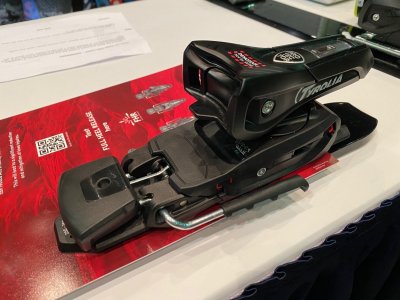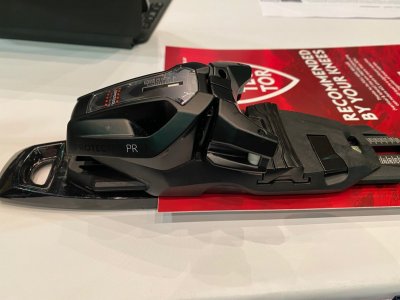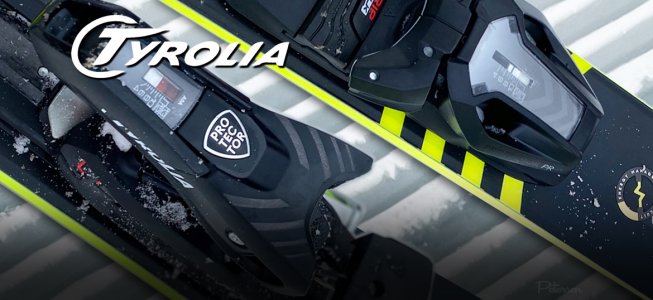Background:
There is an old saying, the early bird gets the worm but the second mouse gets the cheese. Tyrolia’s new Protector binding is the epitome of being a second mouse. No, Tyrolia is NOT the first binding to offer lateral release from the heel; this concept goes way back to the plate bindings of the 1970‘s. This is when Tyrolia developed their Diagonal release which they still offer on some of their bindings today. The Diagonal release in Tyrolia’s heels was important when we were skiing long straight skis and were more susceptible to forward twisting falls. We are in a different time now with different shapes of skis falling different ways, but mostly those falls are in a rearward twisting fashion.
It is no secret that Tyrolia is not the first manufacturer to address the “phantom foot” fall. Kneebinding has been around for more than a decade with a lateral heel that was designed to help minimize the risk to the knee in such a fall. It is my opinion that Tyrolia looked at what was available, and with their extensive resources in experience, design and engineering created [important to point out] patented [important to point out] and produced what they felt was indeed a better concept to help to mitigate knee injury. That new design is the Protector.
There are a lot of things that Tyrolia has addressed and designed correctly with the new Protector series of bindings. First, they started with existing platforms (plate systems that have been used for years) to build upon their proven PRD and Attack toes, making the Protector backwards compatible. (More on that later). The two distinct design aspects of their new heel is the capability to release in either direction (so you are not limited to having a left and right ski) and the existence of 7 mm of elasticity before lateral release occurs.
In basic form, the Protector has your typical binding release settings, one in the toe and one in the heel. The elasticity of the heel is NOT an ISO setting, and does not require to have a ASTM release test. Why? Release settings were designed to protect bone breakage; the Protector setting in the heel is there to protect ligament damage. The setting will correlate with the traditional binding number but that is the extent of it. More on this later too.
On the snow experience and…..Do not attempt this at home
 I was really excited to take the Protector out on the snow on two different skis to see if I can feel a difference compared to Tyrolia’s regular PRD binding. I can say with confidence I could not, which is a plus. When I am at trade shows I usually run my bindings at 8 which is my “chart setting.” So it was natural for me to set the heel’s elasticity at a correlating 8. I had no issues with this setting on my first run.
I was really excited to take the Protector out on the snow on two different skis to see if I can feel a difference compared to Tyrolia’s regular PRD binding. I can say with confidence I could not, which is a plus. When I am at trade shows I usually run my bindings at 8 which is my “chart setting.” So it was natural for me to set the heel’s elasticity at a correlating 8. I had no issues with this setting on my first run.
So what is an inquisitive binding geek‘s next step? Obviously to see if I can get the heel to release laterally. I initially tried to get a release by lifting my leg to the side and slamming the edge to the ground. In the 3 times I tried this, the toe released first. My next idea was to turn the lateral release all the way down to 4. Now, the heel did release laterally. I then tried the ole twist-to-release method us old timers used before DIN to test our release setting, and the heel released. I will add, the lateral release even at the lowest setting still took some force but I didn’t feel any stress on my knee. The next step was to ski the binding at the low setting. I skied on varied terrain, from groomers where I was creating little to no lateral force, to chalky off piste bumps where different forces to the heel were applied. I could not feel the difference between the one binding set at 8 in the toe, 8 in the heel and 8 in the lateral, and the other set the same except for a lateral setting at 4. PLEASE NOTE: Tyrolia does NOT recommend, endorse, condone or support this type of testing in any form or manner. In fact, they really frown upon it.
Because of all the extra mechanisms under the heel to allow for the lateral release design, the Protector’s stack height is on par with Tyrolia’s other system and demo bindings, around 34 mm in the heel and 32 mm in the toe. This is acceptable considering what the Protector brings to the table. Tyrolia, Head and their partnering brands (Elan, Fischer and others) will be offering the Protector as an option on some of their system bindings at a $150-200 premium over the standard counterpart. Considering what the average insurance deductible or copay is, that is a small upcharge for a significant return of safety. The Protector will also be available as a stand alone binding in an 11 and 13 DIN with the PRD toe, and as the Attack with street price ranging from $349 for the Protector PR 11 GW and $399 for either the Protector PR 13 GW or Protector Attack 13 MN. As I mentioned earlier, the Protector is backwards compatible. If you are currently skiing a ski that has a PRD-derived or Attack2 demo binding, you can purchase a Protector and it will slide onto your current track without the need to remount. Of course we recommend to get a full ASTM check.
There is an old saying, the early bird gets the worm but the second mouse gets the cheese. Tyrolia’s new Protector binding is the epitome of being a second mouse. No, Tyrolia is NOT the first binding to offer lateral release from the heel; this concept goes way back to the plate bindings of the 1970‘s. This is when Tyrolia developed their Diagonal release which they still offer on some of their bindings today. The Diagonal release in Tyrolia’s heels was important when we were skiing long straight skis and were more susceptible to forward twisting falls. We are in a different time now with different shapes of skis falling different ways, but mostly those falls are in a rearward twisting fashion.
It is no secret that Tyrolia is not the first manufacturer to address the “phantom foot” fall. Kneebinding has been around for more than a decade with a lateral heel that was designed to help minimize the risk to the knee in such a fall. It is my opinion that Tyrolia looked at what was available, and with their extensive resources in experience, design and engineering created [important to point out] patented [important to point out] and produced what they felt was indeed a better concept to help to mitigate knee injury. That new design is the Protector.
There are a lot of things that Tyrolia has addressed and designed correctly with the new Protector series of bindings. First, they started with existing platforms (plate systems that have been used for years) to build upon their proven PRD and Attack toes, making the Protector backwards compatible. (More on that later). The two distinct design aspects of their new heel is the capability to release in either direction (so you are not limited to having a left and right ski) and the existence of 7 mm of elasticity before lateral release occurs.
In basic form, the Protector has your typical binding release settings, one in the toe and one in the heel. The elasticity of the heel is NOT an ISO setting, and does not require to have a ASTM release test. Why? Release settings were designed to protect bone breakage; the Protector setting in the heel is there to protect ligament damage. The setting will correlate with the traditional binding number but that is the extent of it. More on this later too.
On the snow experience and…..Do not attempt this at home
So what is an inquisitive binding geek‘s next step? Obviously to see if I can get the heel to release laterally. I initially tried to get a release by lifting my leg to the side and slamming the edge to the ground. In the 3 times I tried this, the toe released first. My next idea was to turn the lateral release all the way down to 4. Now, the heel did release laterally. I then tried the ole twist-to-release method us old timers used before DIN to test our release setting, and the heel released. I will add, the lateral release even at the lowest setting still took some force but I didn’t feel any stress on my knee. The next step was to ski the binding at the low setting. I skied on varied terrain, from groomers where I was creating little to no lateral force, to chalky off piste bumps where different forces to the heel were applied. I could not feel the difference between the one binding set at 8 in the toe, 8 in the heel and 8 in the lateral, and the other set the same except for a lateral setting at 4. PLEASE NOTE: Tyrolia does NOT recommend, endorse, condone or support this type of testing in any form or manner. In fact, they really frown upon it.
Because of all the extra mechanisms under the heel to allow for the lateral release design, the Protector’s stack height is on par with Tyrolia’s other system and demo bindings, around 34 mm in the heel and 32 mm in the toe. This is acceptable considering what the Protector brings to the table. Tyrolia, Head and their partnering brands (Elan, Fischer and others) will be offering the Protector as an option on some of their system bindings at a $150-200 premium over the standard counterpart. Considering what the average insurance deductible or copay is, that is a small upcharge for a significant return of safety. The Protector will also be available as a stand alone binding in an 11 and 13 DIN with the PRD toe, and as the Attack with street price ranging from $349 for the Protector PR 11 GW and $399 for either the Protector PR 13 GW or Protector Attack 13 MN. As I mentioned earlier, the Protector is backwards compatible. If you are currently skiing a ski that has a PRD-derived or Attack2 demo binding, you can purchase a Protector and it will slide onto your current track without the need to remount. Of course we recommend to get a full ASTM check.
- Who it is for: Do you have knees? Do you have knee issues or concerns?
- Who might it not be for: High level skiers/racers who are willing to sacrifice life and limb over release. Where a binding releasing could mean severe injury or not crossing the finish line.
- Who is it not for: Those with short BSL’s and higher settings, a single cam heel can be tougher to get into and ironically can put undo pressure on the knee. This is not too dissimilar to most single pivot heels.
- Insider Tip: If there are any shop owners/buyers reading this article, my suggestion to you is when placing your orders for next season, select the Protector on any system skis over the traditional offering, if that is an option.
- One thing I would change: If there was a way to lower the stack height specifically as a non-system option, I would like to see that.


